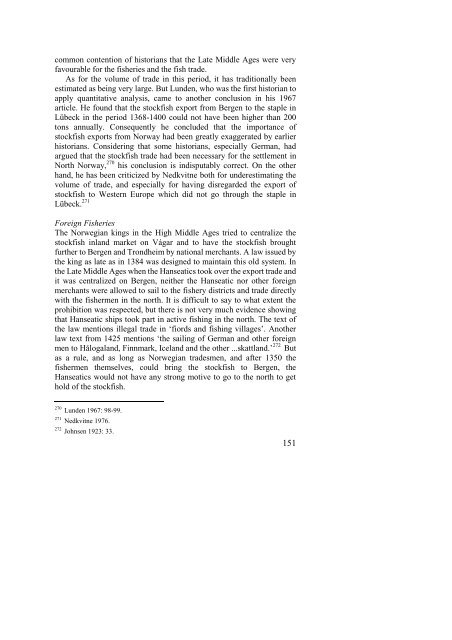The North Atlantic Fisheries, 1100-1976 - University of Hull
The North Atlantic Fisheries, 1100-1976 - University of Hull
The North Atlantic Fisheries, 1100-1976 - University of Hull
You also want an ePaper? Increase the reach of your titles
YUMPU automatically turns print PDFs into web optimized ePapers that Google loves.
common contention <strong>of</strong> historians that the Late Middle Ages were very<br />
favourable for the fisheries and the fish trade.<br />
As for the volume <strong>of</strong> trade in this period, it has traditionally been<br />
estimated as being very large. But Lunden, who was the first historian to<br />
apply quantitative analysis, came to another conclusion in his 1967<br />
article. He found that the stockfish export from Bergen to the staple in<br />
Lübeck in the period 1368-1400 could not have been higher than 200<br />
tons annually. Consequently he concluded that the importance <strong>of</strong><br />
stockfish exports from Norway had been greatly exaggerated by earlier<br />
historians. Considering that some historians, especially German, had<br />
argued that the stockfish trade had been necessary for the settlement in<br />
<strong>North</strong> Norway, 270 his conclusion is indisputably correct. On the other<br />
hand, he has been criticized by Nedkvitne both for underestimating the<br />
volume <strong>of</strong> trade, and especially for having disregarded the export <strong>of</strong><br />
stockfish to Western Europe which did not go through the staple in<br />
Lübeck. 271<br />
Foreign <strong>Fisheries</strong><br />
<strong>The</strong> Norwegian kings in the High Middle Ages tried to centralize the<br />
stockfish inland market on Vágar and to have the stockfish brought<br />
further to Bergen and Trondheim by national merchants. A law issued by<br />
the king as late as in 1384 was designed to maintain this old system. In<br />
the Late Middle Ages when the Hanseatics took over the export trade and<br />
it was centralized on Bergen, neither the Hanseatic nor other foreign<br />
merchants were allowed to sail to the fishery districts and trade directly<br />
with the fishermen in the north. It is difficult to say to what extent the<br />
prohibition was respected, but there is not very much evidence showing<br />
that Hanseatic ships took part in active fishing in the north. <strong>The</strong> text <strong>of</strong><br />
the law mentions illegal trade in ‘fiords and fishing villages’. Another<br />
law text from 1425 mentions ‘the sailing <strong>of</strong> German and other foreign<br />
men to Hålogaland, Finnmark, Iceland and the other ...skattland.’ 272 But<br />
as a rule, and as long as Norwegian tradesmen, and after 1350 the<br />
fishermen themselves, could bring the stockfish to Bergen, the<br />
Hanseatics would not have any strong motive to go to the north to get<br />
hold <strong>of</strong> the stockfish.<br />
270 Lunden 1967: 98-99.<br />
271 Nedkvitne <strong>1976</strong>.<br />
272 Johnsen 1923: 33.<br />
151















